Exploring the Foil Board: A Comprehensive Guide

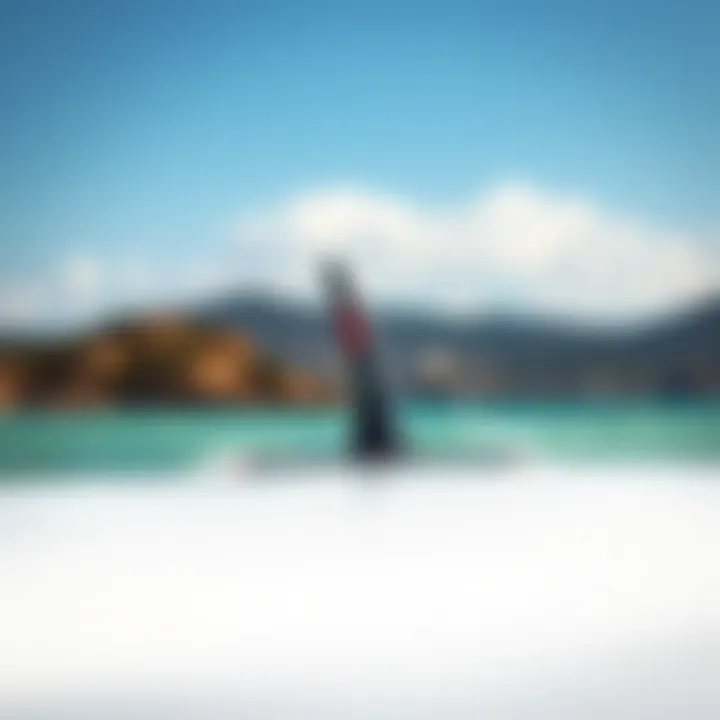
Expert Insights
In the dynamic world of watersports, foil boards have taken center stage as an innovative way to experience the water like never before. The simplicity combined with the thrill of hydrofoiling offers a blend of excitement and challenge that caters to a wide range of enthusiasts, from casual beachgoers to seasoned riders.
Latest Trends in Watersports
Foil boarding has seen a surge in popularity recently, much like how smartphones revolutionized communication. The community around foil boards is rich with creativity, involving all kinds of adaptations, from building custom setups to using cutting-edge materials. Recently, we have seen manufacturers introducing hybrid boards that combine other watersport elements, like kitesurfing or paddleboarding, into the typhoon of foil riding. These have allowed riders to gain lift earlier and maintain speed with less effort. The rapid development in technology is paving the way for lighter and more durable designs, extending the reach for both beginners and professionals.
Safety Protocols and Best Practices
When it comes to foil boarding, ensuring safety is paramount. Riders should consider the following protocols:
- Wear Appropriate Gear: A well-fitted life jacket, helmet, and impact vest can be life-saving during falls or collisions.
- Choose the Right Environment: Flat water conditions are often ideal for beginners, while more experienced riders may seek out ocean swells.
- Stay Aware: Keep an eye on surroundings to avoid other craft and swimmers that may pose a risk.
- Practice Your Falls: Learning how to fall safely can greatly reduce the risk of injury.
"Always respect the water; it gives, and it takes away. Understanding its power is part of being a responsible rider."
Equipment Recommendations
The right equipment can make or break your foil boarding experience. Here’s a concise guide to gear suited for every level.
Must-Have Gear for Beginners
- Foil Board: Look for boards designed for novices with wider fuselage and greater stability. Brands like Duotone and Naish have reliable options.
- Foil Setup: A lower aspect foil is advisable for beginners. They are easier to control and provide smooth gliding.
- Wetsuit or Drysuit: Depending on your local climate, ensuring body warmth is essential.
- Leash: A safety leash can keep your board close when you fall, making it easier to regain control.
Advanced Equipment for Pros
As you move up the learning curve, selecting advanced equipment becomes crucial:
- High-Aspect Foils: These designs, like those offered by Slingshot and F-One, enhance performance and offer sharper turns.
- Lightweight Boards: Look for materials like carbon fiber to enhance responsiveness while reducing weight.
- Adjustable Fuselage: Enables versatile riding conditions and custom adjustments according to weather or style preferences.
Staying at the forefront of foil board technology requires following brands and forums, learning from community discussions on platforms like Reddit and dedicated Facebook groups.
Investing in quality gear not only contributes to performance but also promotes safety, ensuring that your time on the water is enjoyable and fulfilling. As you integrate foil boards into your watersport arsenal, be prepared to embrace the unique experience they offer, from carving waves to gliding effortlessly above the water.
Understanding Foil Boards
Foil boards have carved their niche in the world of watersports, capturing the interest of athletes and recreationists alike. The allure lies not just in their sleek design, but also in how they fundamentally change the way one interacts with water. With the ability to glide above the surface, foil boards open up possibilities for speed, agility, and a unique riding experience.
Understanding foil boards involves more than just scratching the surface. It requires an appreciation of their design, functionality, and the specific components that make them a go-to choice for many enthusiasts. By delving into the elements that comprise a foil board, one can better comprehend its advantages and how to effectively utilize them in various watersport activities. With a deep understanding, users are well-equipped to make informed decisions about their gear, ensuring an optimized experience on the water.
Definition and Basic Concepts
A foil board can be succinctly defined as a board equipped with a submerged wing, called a foil, which lifts the board above the water’s surface when in motion. This lift reduces drag, allowing for higher speeds and smoother glides. Typically, these boards are used in activities such as surfing, kiteboarding, and windsurfing. The primary appeal lies in the sensation of flying over water, offering a new dimension to riding.
Components of a Foil Board
Understanding what makes up a foil board is crucial because each component plays an essential role in its overall performance. The three main parts of a foil board include the board itself, the foil, and the mast.
Board
The board serves as the platform from which riders navigate. Generally constructed from lightweight materials like foam or carbon fiber, these boards are designed for buoyancy while still being sturdy. A key characteristic of the board is its shape; different outlines affect how the board behaves in the water. Choosing the right board can mean the difference between a seamless ride and a struggle. Some boards offer a slight concave bottom, which can enhance stability and control, while others might focus on speed and performance.
The unique feature here is the volume and size of the board, which can greatly influence how a rider balances and maneuvers. Riders may find wider boards more stable, especially beginners, while advanced users may opt for narrower options that allow for better responsiveness.
Foil
The foil itself is perhaps the most critical component. It is usually fashioned from a combination of aluminum and carbon, providing the right balance of strength and weight. The foil consists of two main parts: the front wing and the fuselage. The front wing generates lift, while the fuselage connects the wing to the mast and board. A paramount characteristic of the foil is its aspect ratio—the ratio of the wingspan to its chord (width). A higher aspect ratio means better efficiency and speed, while a lower ratio might offer more stability and maneuverability.
One must weigh the advantages against disadvantages; foils with larger wings can generate more lift but could become harder to control in choppy conditions.
Mast
The mast connects the board and the foil, acting as the vertical support. Masts come in varying heights, with taller masts allowing for a greater level of flight over the water surface. Generally, those who are just getting started might choose shorter masts, as they provide a more manageable ride.
A notable characteristic of the mast is its material—often made from composite materials, it aims to provide elasticity while maintaining rigidity. The challenge here lies in finding a balance; a lightweight mast can enhance speed and lift, but a sturdier mast may lend more control in turbulent waters.
In summary, knowing the specific components of a foil board and their unique characteristics can dramatically improve one’s riding experience. Every choice impacts performance, making it essential for riders to thoroughly consider their options, whether they are seasoned pros or newcomers wandering into this thrilling world.
The Evolution of Foil Boards
The journey of foil boards reflects a fascinating marriage between surfing tradition and modern engineering. Understanding the evolution of these boards is vital not just for enthusiasts but also for anyone who wants to appreciate this sport on a deeper level. The iterative improvements over the years speak to the ingenuity of designers and the needs of riders, leading to enhanced performance and safety. As you peel back the layers of history and technology, it becomes clear that foil boards have transformed not only how board sports are performed but also how riders engage with the water itself.
Historical Background
In the realm of watersports, foil boarding is relatively new, having gained traction only in the last two decades. The origins of foil boards can be traced to the 1960s when the first concepts emerged. A notable figure in this domain is Bob Simmons, who experimented with hydrofoil designs. His work laid the groundwork for later advancements. However, it wasn't until the late 1990s that commercially viable versions began surfacing. This was largely spearheaded by modern materials like carbon fiber and advancements in engineering.
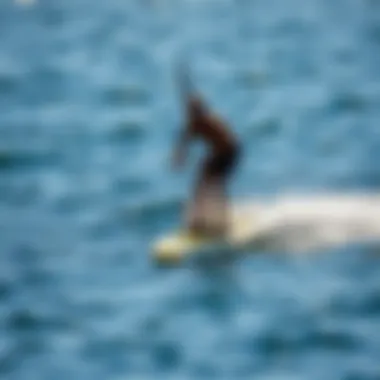
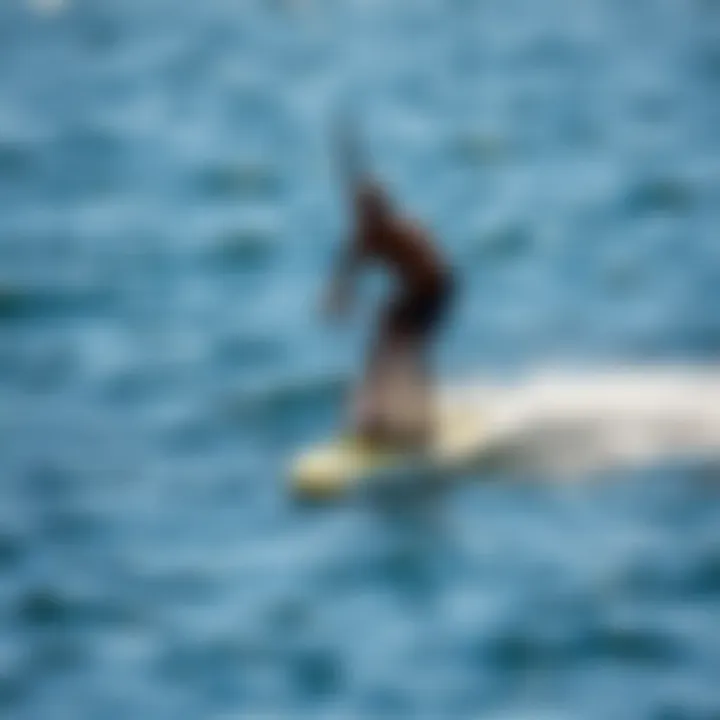
Throughout the 2000s, various enthusiasts started adapting the foil concept into kitesurfing and surfing, leading to a surge in popularity. The early adopters who embraced foil technology faced a steep learning curve; the boards were often unwieldy and challenging to control. Nevertheless, the appeal of gliding above water attracted both thrill-seekers and those pursuing a calmer ride. Bursting onto the scene in major competitions, these boards began to earn their stripes, slowly building a following.
Technological Advances
Fast forward to the present, and the technology supporting foil boards has developed at breakneck speed. The integration of wind tunnels for aerodynamic testing led to new designs, enhancing lift and decreasing drag. Most modern foil boards benefit from high-performance wings made from lightweight materials. Riders now have options tailored to specific styles— surf foiling, kite foiling, and wing foiling—requiring unique wing structures that adapt to the demands of each different discipline.
The advent of adjustable mast heights allows riders to fine-tune their setup according to water conditions, significantly improving their efficiency. Another key advancement is the introduction of foil mount systems, enabling quick changes in configuration without compromising stability.
"The evolution of foil boards isn’t just about better materials; it’s about rethinking what is possible on water."
Moreover, software and sensor technology play a growing role in performance analysis. Real-time data collected by wearables helps athletes optimize their techniques for improved speed and control. This ongoing dialogue between technology and rider feedback continues to shape the future of foil boarding.
In sum, the evolution of foil boards illustrates a dynamic interplay between experimentation and refinement. With each leap in technology, riders uncover new possibilities, transforming not just their sport but their experience in the water.
Hydrodynamics and Performance
Understanding the hydrodynamics of foil boards is critical for anyone looking to maximize their performance and enjoyment on the water. The way water interacts with the board and foil directly affects speed, stability, and overall maneuverability. This crucial interplay determines how effectively a board can glide through water, creating lift while reducing drag.
How Foil Boards Work
Foil boards operate on the principle of lift, akin to how an airplane wing functions. When a foil board is in motion, the underside of the foil generates lift due to the difference in water pressure above and below the wing. This effect allows the board to rise above the water surface, significantly reducing drag.
When using a foil board, there are some key elements to keep in mind:
- Speed: The speed necessary to achieve lift varies depending on the wing design and conditions; faster movements usually yield quicker liftoff.
- Angle of Attack: Adjusting the angle of the foil impacts how much lift is generated. A higher angle increases lift but also the risk of stalling.
- Water Conditions: Waves and chop can greatly influence the performance of the board. Smoother water enables easier lift and control.
To achieve effective performance, a rider must find the right combination of speed, positioning, and board characteristics that align with the water conditions. For additional insights, various forums and expert articles can be useful. Check out resources like Reddit and Wikipedia.
Speed and Maneuverability
Speed and maneuverability are two sides of the same coin when it comes to foil boarding. While speed is essential for achieving lift, maneuverability allows the rider to control their path effectively.
Influential Factors:
- Board Design: The shape and size of the board influences how it cuts through the water. A longer board can provide stability but may sacrifice swift turns.
- Foil Size: Larger foils generally produce more lift but can make the board feel sluggish on quick turns. Smaller foils, conversely, enhance agility but may require higher speeds.
- Rider Experience: As with most sports, skill plays a pivotal role. More experienced riders can navigate and control their boards with precision, whereas beginners may experience difficulties at higher speeds.
Additionally, changing conditions such as wind direction or currents can add complexity to maneuvers. Practicing in varied environments helps riders develop the intuition needed to adjust their techniques in real-time.
"In the water, every wave's a teacher, but only if you're paying attention."
Ultimately, understanding how hydrodynamics works within the context of performance greatly contributes to maximizing the joys of foil boarding. An adept rider can harness this knowledge to excel, pushing not just their limits, but the boundaries of what is possible on the water.
Types of Foil Boards
Understanding the various types of foil boards is essential for anyone looking to engage with this exciting watersport. Each type of foil board is designed with specific characteristics that cater to different environments and riding styles, making it crucial for athletes, coaches, and recreationists to choose the right board for their needs. Here, we'll explore three main categories: surf foil boards, kite foil boards, and wing foil boards. Each of these boards offers unique benefits, but they also come with their own considerations to bear in mind.
Surf Foil Boards
Surf foil boards integrate many of the principles of traditional surfing with the innovative technology of foiling. These boards are typically shorter and wider, providing increased stability, making them well-suited for small to moderate waves. Riders benefit from the lift provided by the foil beneath the water, allowing them to glide effortlessly across the surface and ride waves that might otherwise be unmanageable.
One significant advantage of surf foil boards is their ability to tap into energy from the wave, which can enhance performance and extend riding time. However, they require an understanding of wave dynamics and proper paddle technique. If you're planning to enter this sport, starting with a larger, more forgiving board can help you balance while mastering the motions involved.
Kite Foil Boards
Kite foil boards are designed specifically for kite surfing, combining the elements of kites and foils to create an exhilarating riding landscape. These boards are typically slightly longer than standard kiteboards and possess a pronounced hydrofoil that enables lift even in light winds. The result is a smoother ride that allows for faster speeds and more acrobatic maneuvers.
What sets kite foil boards apart is that they empower riders to maintain speed and control while experiencing a heightened sense of freedom on the water. However, kite foiling does come with a learning curve. Keeping your balance while managing the kite's pull can be tricky but rewarding once you get the hang of it. Choosing the right wing size and board length based on your skill level and wind conditions is critical.
Wing Foil Boards
Wing foil boards blend the traits of both surfing and kite surfing with a unique wing system that allows for propulsion. Unlike traditional kites or sails, these wings are handheld and are used to harness the wind's power while riding on the water. This type of foiling is highly versatile, approachable for beginners, yet offers advanced capabilities for seasoned riders as well.
The beauty of wing foiling lies in its simplicity before and after catching a breeze. You can take off from land, cruise effortlessly, or even enjoy lake waves. However, like other foil types, selecting the appropriate board size and wing design is essential for maximizing performance. Riders should also take note of their surroundings to ensure adequate safety when learning and practicing.
Foil boarding, whether surfing, kiting, or winging, opens up a world of possibilities on the water. Selecting the right type can make all the difference in your enjoyment and mastery of the sport.
In summary, each type of foil board offers unique advantages suited to different styles of riding. Whether you’re drawn to the waves of surf foiling, the thrill of kite boarding, or the new sensation offered by wing foiling, understanding your type helps maximize your experience on the water. Make sure to consider your skill level, environmental conditions, and personal preferences before making a choice.
Choosing the Right Foil Board
Choosing the right foil board is a pivotal aspect of any watersport enthusiast's journey. When you’re looking to glide above water with minimal drag, the equipment you select fundamentally influences your experience. The right board not only impacts your performance but also shapes your enjoyment on the water. One must consider various factors to find a suitable match, ensuring both safety and thrill.
Factors to Consider
Skill Level

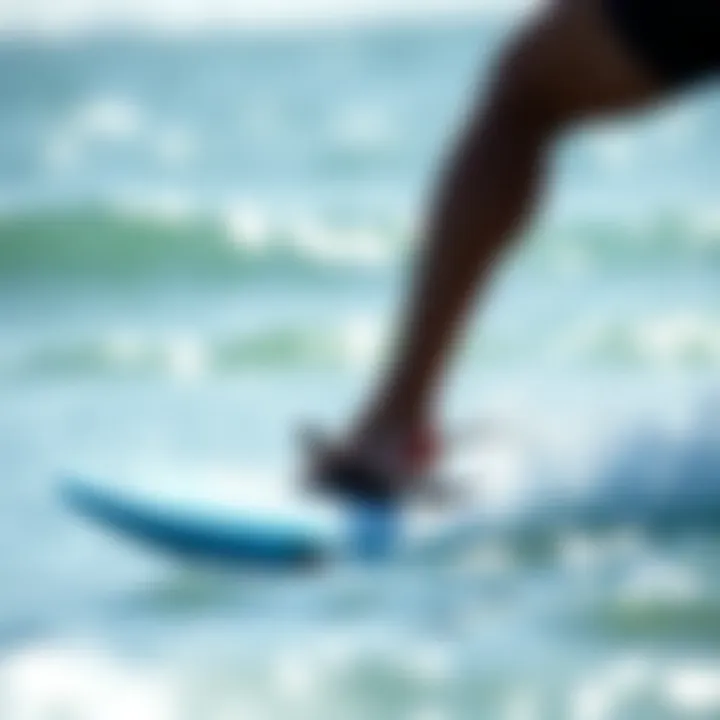
The skill level of a rider plays a crucial role in the selection of a foil board. A novice might feel overwhelmed by a board designed for experts. Generally, beginners should opt for boards that offer stability and ease of use. This means looking for boards with wider outlines, which grant more balance.
A board tailored for beginners often has a larger surface area. This characteristic provides extra buoyancy, making it easier to rise and ride without frequent crashes. On the flip side, a more advanced rider often seeks a smaller, more agile board, tailored for intricate maneuvers. The risk here can lead to accelerated learning curves, but it can also result in falls or difficulties if one isn't properly trained. Thus, understanding one’s skill level is essential to cultivate an enjoyable and safe experience.
Board Size
Moving on to board size, this aspect is crucial for both performance and control. Smaller boards offer greater speed and responsiveness, catering to experienced riders looking for thrill in tricky conditions. They can also ride higher, catching the wind more effectively, which aids in speed. However, smaller boards can feel unstable, especially when conditions get choppy.
For a learner, a larger board is often the better fish to fry. Its size helps with stability, making it easier to maintain balance during those early sessions. A larger surface area also seems to make it easier to catch waves, which can significantly enhance a beginner's confidence. Balancing board size with intended performance can make or break the ride.
Wing Size
Finally, the wing size on a foil board is the unsung hero of the setup. Larger wings provide greater lift, allowing the rider to take off at lower speeds, making them an ideal pick for those just starting out. They can glide longer with less effort, a blessing when learning to ride.
On the contrary, smaller wings are typically favored by advanced foil boarders looking for speed and agility. They allow for sharp turns and quick lifts but require a stronger skill set to handle effectively. Choosing the correct wing size depends heavily on not only the rider’s level but also the riding conditions.
In essence, understanding these three factors—skill level, board size, and wing size—can significantly influence one’s experience on the water, making the choice of foil board more than just a simple decision; it’s a blend of art, technique, and personal preference.
Top Brands and Models
When it comes to selecting a foil board, considering reputable brands is paramount. Popular names like Slingshot, Naish, and Fanatic stand out in the market, known for their quality and performance. Riders should look into various models these brands offer, assessing how each one aligns with their unique needs and riding style.
In the end, a successful pursuit of mastering foil boarding is underpinned by the right choice of equipment. Investing time into understanding the dynamics of your board can yield a more gratifying experience on the water.
Techniques for Mastery
Techniques for mastery play a pivotal role when it comes to foil boarding; understanding them can elevate your experience on the water from mundane to exhilarating. Mastering these techniques not only improves your skills but also enhances safety, performance, and enjoyment. Whether you’re a novice or a seasoned rider, embracing these practices can fine-tune your approach, making it a lot more enjoyable and productive.
Getting Started
When dipping your toes into the world of foil boarding, the key is to take a methodical approach. First and foremost, you wanna get familiar with your equipment. Knowing how your foil board operates can save you a heap of trouble later on.
- Safety First: Equip yourself with essential gear like a helmet, impact vest, and a leash to keep your board nearby if you take a tumble. In this sport, it can be easy to lose control, so having the right safety measures is non-negotiable.
- Choose the Right Location: Look for a calm water body suited for beginners. A flat lake or a slow-moving section of a river can provide a more controlled environment to practice. The last thing you'd want is choppy waves throwing you off balance before you even get started.
- Practice Balance: Start with basic balance drills while standing on the board. Remember, you want to feel comfortable with the foil under your feet before taking the plunge into more advanced maneuvers. The goal is to train your body to adjust and respond to the foil's reactions.
- Controlled Takeoffs: When you're ready for lift-off, keep your weight centered on the board, using your back foot to control the tilt of the foil. Engage your core to maintain stability. If you lean too far, you might end up plummeting back to the water instead of soaring.
In a nutshell, the starting phase of learning to foil board sets the groundwork for everything else. Don't rush through it, and be gentle with yourself as you learn the ropes.
Advanced Maneuvers
Once you've got the hang of the basics, it's time to dive into advanced maneuvers. These techniques can take your skills from basic riding to artistic expressions on the water.
- Carving Turns: Initiate a turn by pressing down on your back foot to pivot the nose of the board. Aim to shift your weight smoothly between your feet. This practice is essential as it helps maintain lift while maneuvering.
- Jumping: When you feel confident, you can experiment with jumping. To do this, compress your knees and push off the water with a controlled lift. It’s all about timing, and just remember that the success of your leap relies heavily on having good balance.
"Mastering foil boarding is not only about skill, but confidence is key. When you're mentally tuned in, you ride with a fluidity that’s hard to match."
- Tricks and Stunts: As you gain more confidence, you might want to showcase some tricks like 180-degree spins or even flips. Start small, practicing basics like a simple spin before trying more intricate tricks. Keep in mind that the learning curve can be steep and patience is your best friend.
- Slalom Riding: This technique involves riding in a zig-zag pattern to build your control and agility on the board. It’s about learning to navigate your body in response to the foil and water conditions.
Each of these advanced maneuvers enhances your overall foil boarding experience, giving you that dose of adrenaline while ensuring you maintain control. Over time, they can lead to a distinct style that makes you stand out on the water.
As you continue to refine your techniques, remember that mastery isn't attained overnight. The journey, with its ups and downs, is what truly enriches the experience of foil boarding.
For more detailed insights on foil boarding and safety tips, you might find useful resources at Wikipedia, Britannica, and community forums like Reddit or groups on Facebook.
Safety Considerations
Engaging in foil boarding is an exhilarating experience, but safety must always take precedence. Understanding the particular dangers associated with foil boarding can make the difference between a thrilling day on the water and a trip to the emergency room. Weather conditions, visibility, and equipment integrity play crucial roles in ensuring a safe outing. This section highlights essential safety gear and common hazards to keep enthusiasts out of harm’s way, enabling a more enjoyable and secure experience.
Safety Gear Essentials
Having the right safety gear can provide peace of mind while you're riding the waves on a foil board. Here’s a breakdown of essentials:
- Helmet: Protect your noggin. A well-fitted helmet can shield you from head injuries, especially when you’re learning.
- Impact Vest: Not just for style, an impact vest cushions any hard knocks, making a world of difference in tumbles.
- Wetsuit: Besides warmth, a wetsuit provides a certain amount of buoyancy and can help with protection against the sharp edges of the foil.
- Leash: A leash can be a lifesaver. If you wipe out, it keeps your board close, preventing it from floating away and reducing the risk of collisions.
"In water sports, being prepared can sometimes be the difference between a fun adventure and a scary incident."
It’s also wise to carry a first-aid kit, a knife for emergencies, and a signaling device, like a whistle or flare, especially when venturing into vast waters.
Common Hazards
Foil boarding presents several hazards that practitioners should be aware of. Recognizing them can help mitigate risks families face during their aquatic adventures. Here’s a list of potential hazards:
- Foil Strikes: The foil can be sharp, and if you fall at the wrong angle, the risk of injury is elevated, especially to limbs. Always maintain awareness of your surroundings.
- Weather Conditions: Sudden changes in the wind or weather can create dangerous situations. Always check forecasts before heading out.
- Crowded Waters: Other surfers, boats, and obstacles can pose dangers. Maintaining distance from other water users is always vital.
- Equipment Failure: Inspect your gear before use. A malfunction could lead to accidents, so make it a habit to check your board, foil, and connections regularly.
Being mindful of safety gear and hazards enhances not only personal safety but also helps to create a safe environment for everyone enjoying the sport. By being well-informed, fellow enthusiasts can amplify their adrenaline rush while minimizing the risk associated with foil boarding.
Foil Board Maintenance
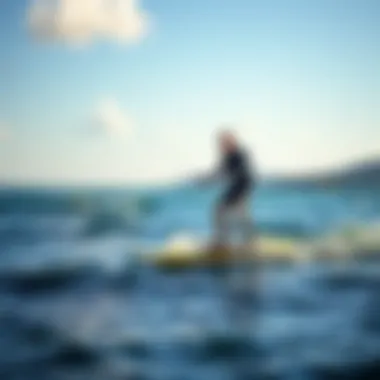
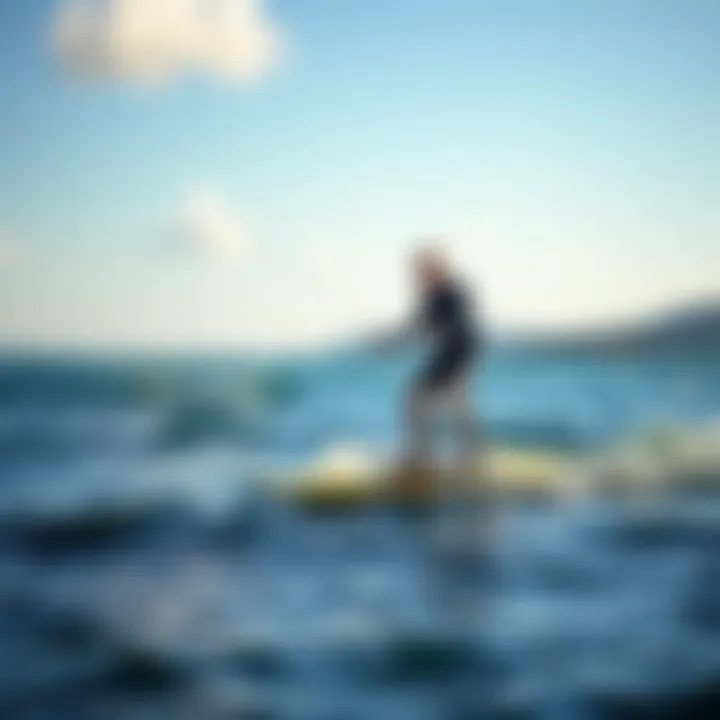
Maintaining a foil board is crucial for not only ensuring its longevity but also maximizing performance in the water. Like a classical violin that thrives on care, a foil board's condition directly influences your riding experience. Keeping it in tip-top shape means you can glide over waves and cut through water like a hot knife through butter.
There are a few essential elements that come into play when discussing maintenance: cleaning, care, repairs, and the intricacies of troubleshooting. Each of these topics holds its weight in ensuring that foil board enthusiasts can enjoy their sport without a hitch.
Cleaning and Care
One of the first steps in foil board maintenance is cleaning. After every session on the water, it's wise to rinse your board with fresh water. Salt and sand have a knack for sticking to surfaces, so giving your board a proper wash can help avert corrosion or other damages that arise over time.
Here are a few pointers on how to properly clean and care for your foil board:
- Rinse with Fresh Water: Ensure you rinse off your board immediately after use. This helps remove salt and debris.
- Check for Damage: Look for any cracks or signs of wear during the cleaning process. If you notice something amiss, it's best to address it before your next outing.
- Dry Thoroughly: Hang your board up in a shaded spot to dry. Avoid direct sunlight for long periods as it could weaken materials over time.
- Store Properly: Keep the board in a cool, dry place when not in use. Using a board bag can add an extra layer of protection against dings and scratches.
Caring for your foil board goes beyond just cleaning. Regular checks and timely maintenance when needed can save you money and headaches in the long run.
Repairs and Troubleshooting
Even with the best care, sometimes things go awry. Knowing how to perform basic repairs or troubleshoot common issues can make a significant difference in your paddle sessions. Here’s where the rubber meets the road.
When it comes to repairs, several common issues might arise:
- Dents and Dings: These usually happen during transport or accidental collisions. Use epoxy or marine-grade repair kits to patch larger areas.
- Foil Damage: If the foil gets bent or damaged, it can alter your performance. Straightening it, if it’s a minor bend, is often possible but may require specialized tools.
- Mast Connection Issues: If the mast does not connect firmly with the board, ensure that all screws and bolts are sixe tightened and free from rust. Replacement parts are often found from major brands.
- Leakage: In rare cases, your board may develop leaks. Apply repair kits these issues quickly to avoid further deterioration.
When tackling any repairs, patience is key. Take your time with the repairs; a haphazard job can lead to further problems down the line.
In essence, proper foil board maintenance hinges on a blend of cleaning, care, and repairing. By understanding the basic needs of your board, you can considerably enhance your experience on the water.
The time you invest in your gear translates to an enhanced experience on the waves, ensuring that each ride is smooth and enjoyable.
For more information on maintenance techniques, check resources like Wikipedia or specialty forums such as Reddit. Remember, a well-maintained foil board is a happy foil board.
Environmental Impact
When diving into the realm of foil boarding, it's essential to consider its environmental footprint. This sport, while exhilarating and transformative, does not exist in a vacuum. The materials we utilize and the practices we adopt can have lasting effects on our planet's ecosystems.
Foil boards, which have gained immense popularity, bring with them both advantages and challenges regarding sustainability and the environment. Understanding these aspects is critical for enthusiasts and industry stakeholders alike. As we ride the waves, we must be mindful of the waves beneath us too.
Sustainability in Materials
Foil boards often consist of a mix of materials that can greatly influence their environmental impact. High-performance boards are typically made from lightweight composites and plastics. However, as the demand for sustainable practices rises, manufacturers are exploring alternative materials.
Some notable eco-friendly options for materials include:
- Bamboo: A rapidly renewable resource, bamboo can be used for boards, offering a strong yet light performance.
- Recycled Plastics: Some brands now fashion foil boards from recycled materials, reducing new plastic consumption and giving waste a new life.
- Natural Resins: Instead of conventional epoxy, some manufacturers opt for natural resin options that minimize VOC emissions during production.
Adopting these innovative materials not only helps protect our environment but also appeals to the growing base of eco-conscious athletes. Although the upfront investment might be higher, many find that the long-term benefits far outweigh any initial expense.
Impact on Marine Ecosystems
Foil boarding takes place in the water, which inherently ties it to the broader health of marine ecosystems. One major concern is the potential for disturbance to marine habitats.
"Awareness and respect for marine environments must be at the forefront of any water sport endeavor."
When practicing foil boarding, we need to be conscious of our surroundings:
- Avoiding sensitive zones: Areas rich with marine life, such as coral reefs or breeding grounds, should be approached with caution; a single errant foil can create disturbances.
- Pollution: The introduction of pollutants from various sources can affect the water quality and subsequently harm aquatic lives. Foil boarders should ensure that their gear is maintained to prevent any chance of leakage or contamination.
- Entanglement: Equipment like lines and foils can be hazardous to marine animals if they become ensnared.
Fostering a healthy relationship with nature is essential for both enjoyment and sustainability. Engaging with local reef or marine conservation efforts can also promote a sense of responsibility among the foil boarding community.
Understanding the environmental implications of foil boards enables riders to make informed choices that benefit not just their sport, but also the world we are part of. Balancing thrills with responsibility is no small feat, but it is one that we should all strive for.
The Future of Foil Boarding
The future of foil boarding promises to be an exhilarating chapter in the realms of watersports, merging cutting-edge technology with the soulful experience of riding the waves. As watersports enthusiasts increasingly seek ways to elevate their experiences, especially in the quest for speed and agility, advancements in foil boarding have not just revolutionized how we glide over water but also expanded the horizons for limitless exploration. This section will navigate through emerging trends and innovations that are set to shape the future of foil boarding, highlighting the importance of these elements for athletes, coaches, and recreationists alike.
Emerging Trends
With each passing year, foil boarding seems to usher in new styles and approaches. Here are some notable trends currently making waves:
- Increased Accessibility: More manufacturers are producing user-friendly foils designed for beginners, allowing a broader range of individuals to experience the thrill of foil boarding. This push toward accessibility is appealing to schools and teaching facilities, ensuring that the sport can reach aspiring athletes across various skill levels.
- Eco-Friendly Designs: As awareness of environmental impact increases, some brands are stepping up to develop eco-conscious foil boards. Materials such as recycled plastics or responsibly sourced wood are becoming common, appealing not just to eco-minded athletes but also to suppliers and consumers looking to reduce their carbon footprint.
- Adoption of Hybrid Boards: Riders are beginning to experiment with hybrid boards that combine aspects of windsurfing and foil boarding. This amalgamation offers versatile performance on various bodies of water, leading to a more diverse experience for enthusiasts.
- Community and Social Integration: The rising influence of social media has led to vibrant communities forming around foil boarding. Events, competitions, and meet-ups are being organized not just for competition but to create a sense of community and camaraderie among enthusiasts.
"The evolution we’re witnessing in foil boarding is a testament to human ingenuity and the desire for exploration on water."
These emerging trends offer exciting possibilities while also fostering a growing culture around foil boarding that can only serve to enhance the community as a whole.
Innovations on the Horizon
As advancements continue to be made, several innovations stand poised to redefine the experience of foil boarding. These can include:
- Smart Technology Integration: Foil boards equipped with sensors to monitor performance metrics like speed, height, and angle of elevation may soon be the norm. This data can provide valuable insights for athletes, allowing them to hone their techniques.
- Improved Hydrodynamics: Research into more efficient wing and hull designs promises to increase performance through enhanced lift and reduced drag. This will result in faster, smoother rides that can handle challenging conditions with ease.
- Customizable Components: An exciting trend is the rise of boards with customizable features. Components that can be easily swapped out based on preferences or conditions will empower athletes to tailor their gear to specific water environments, ensuring optimal performance.
- Safety Innovations: With the increase in interest, safety innovations like integrated flotation systems or advanced impact-resistant materials are becoming more common. These updates aim to mitigate risks associated with high-speed water sports, prioritizing athlete safety.
The future holds a wealth of opportunities for foil boarding, driven by a mix of technological innovation and an evolving community. As we look ahead, those involved in the sport may find themselves part of something truly transformative in how we interact with the water.







